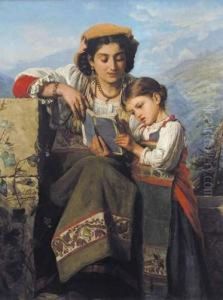Eugeen Siberdt Paintings
Eugeen Siberdt, born on January 21, 1851, in Antwerp, Belgium, was a prominent Belgian painter and illustrator, associated with the Romantic and later Symbolist movements. His art education was rooted in the rich tradition of the Royal Academy of Fine Arts in Antwerp, where he later became an influential teacher. Siberdt's career spanned a period of artistic transition in Europe, as the romantic sensibilities of the 19th century gave way to the modernist impulses of the 20th.
Siberdt is perhaps best known for his role in the education of several notable artists, including Vincent van Gogh, who briefly attended the Antwerp Academy in 1885-1886. Although Siberdt and Van Gogh had a notoriously strained relationship, the rigor of Siberdt’s academic and technical demands contributed to the foundational skills of many artists who would go on to challenge the very conventions they learned under his tutelage. His teaching methods, emphasizing classical drawing and meticulous attention to detail, were both respected and criticized for their rigidity as the Impressionist and Post-Impressionist movements sought to break from traditional academic strictures.
Beyond his teaching, Siberdt’s own work was characterized by a strong narrative quality, often inspired by mythology, history, and literature, aligning him with the Romantic tradition. His paintings are noted for their vibrant use of color, intricate detail, and emotional depth, capturing moments of intense drama and serene beauty with equal proficiency. In the later part of his career, Siberdt began to explore Symbolism, infusing his works with a sense of mystery and a focus on the spiritual and the mystical.
Despite his influence on a generation of artists, Eugeen Siberdt's conservative stance on art made him a somewhat controversial figure, caught between the reverence for classical art forms and the burgeoning avant-garde movements. His legacy, however, is secure in the Belgian art historical canon, as a bridge between the old and the new, and as a mentor to artists who would go on to redefine European art.
Siberdt continued to paint and teach until his later years, leaving behind a body of work that reflects both his adherence to traditional techniques and his occasional foray into more experimental themes. He died on September 4, 1931, in Antwerp, leaving a complex legacy that embodies the transition from 19th-century Romanticism to the dawn of modernist expressions in art. His works remain in collections and museums in Belgium and beyond, a testament to his skill and his pivotal role in the development of Belgian art.
